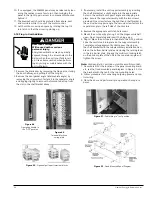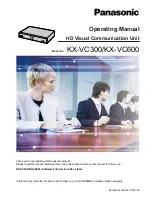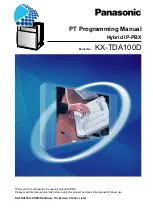
3. Fuse Holders: Replace fuse holders if the insulating mounts,
barriers, or fuse clips show signs of deterioration, heating,
distortion, or looseness.
4. Operating Handle: The disconnecting means must be
replaced if the operating handle fails to open and close the
disconnect device. The door interlock must be inspected
and its proper function verified prior to restoring the
controller to service.
5. Stab Fingers: (Figure 59) Inspect stab fingers as instructed
under Stab Fingers Section and Vertical Bus Section and
replace if necessary. Lubricate stab fingers with approved
lubricant.
5.10 Terminals and Internal Conductors
Replace all damaged parts which show evidence of discolor-
ation, melting, or arcing damage.
5.10.1 Motor Starter
1. Contactor - Replace the contacts and contact springs if the
contacts are welded or show heat damage, displacement of
metal, evidence of binding in the guides, or wear in excess
of wear allowance. If deterioration extends beyond the
contacts, replace the contactor. Examples of such deteriora-
tion include evidence of arcing on the contactor moldings
and insulation damage. Arc chutes must be in place and
secured prior to operating contactor.
2. Overload Relays - a) Any indication of an arc striking or
burning the overload relay may require replacement. b)
Contact operation must be verified by electrically or
mechanically tripping and resetting the relay even if there is
no visual indication of damage that would require
replacement.
3. Fuses - Always replace all three fuses even though only one
or two are open circuited since internal damage suffered by
fuses not replaced could result in nuisance shut down later.
4. Perform the Pre-Energization checks procedures detailed on
Page 29 herein, before restoring the equipment to service.
5.11 Adjustment of SentronTM Type ETI
Instantaneous Trip Motor Circuit Interrupter
(1A-125A)
Hazardous voltage.
Will cause death or serious personal
injury.
Disconnect and lock-out all power and
control voltage sources supplying the
motor circuit interrupter before adjusting
trip setting or performing any other
maintenance operations.
ETI instantaneous trip motor circuit interrupters are supplied as
standard with Size 1 through Size 6 motor starters. The motor
circuit interrupter continuous current rating should not be less
than 115% of motor full load current (MFLC). The MFLC is
obtained from the motor nameplate or from Table 430-150 of
the NEC (1999). Use the following procedure to adjust the
instantaneous trip setting.
1. Move the operating handle to the .OFF. position and open
the unit door.
2. The instantaneous trip circuit breaker is factory set at the
LOW position.
To set: determine motor full load current from the motor
nameplate. Refer to the table and determine the recommend-
ed setting position. Use a screwdriver to set the indicator on
the adjustment screw to the appropriate position.
For maximum protection the trip position should be set as
low as possible. Turn the adjustment screw counterclockwise
to successively lower positions until the breaker trips
on motor starting.
After this position is determined, turn the adjustment screw
clockwise to the next higher setting for normal operation.
The adjustment screw is infinitely adjustable for customer
convenience. If the breaker does not trip at the lowest setting
leave the indicator at this setting.
3. Adjust the trip setting by rotating the adjustment dial to the
position selected in step 2 above.
Siemens Energy & Automation, Inc.
36
Figure 59 -
The stab assembly









































